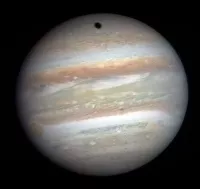Venus, the second planet from the Sun, shares remarkable similarities with Earth in terms of size and mass. However, its atmosphere, primarily composed of carbon dioxide, distinguishes it significantly. This dense atmosphere traps heat, resulting in an extremely high surface temperature of 737 K and a pressure 92 times greater than Earth's sea level pressure. These conditions lead to a supercritical state of carbon dioxide near Venus's surface, blanketed by a thick layer of sulfuric acid clouds.
1961: First Interplanetary Spaceflight Attempt
In 1961, the Soviet Union launched Venera 1, the first attempt at an interplanetary spaceflight. It was intended to fly to Venus but lost contact en route.
December 1962: First Successful Interplanetary Mission
In December 1962, the United States' Mariner 2 mission successfully flew past Venus at a distance of 34,833 km, becoming the first successful interplanetary mission. The probe gathered data on Venus's atmosphere.
1966: First Impact on Venus
The Soviet probe, Venera 3, became the first spacecraft to impact another planet other than the Moon in 1966 when it crashed into Venus. However, it was unable to return any data.
1967: Venera 4 Explores Venus's Atmosphere
In 1967, Venera 4 successfully deployed scientific instruments into Venus's atmosphere. The probe revealed that the surface temperature was much higher than previously thought, reaching almost 500 °C. It also found that the atmosphere was primarily composed of 95% carbon dioxide and was much denser than anticipated.
1967: Soviet-American Space Cooperation
In 1967, a pioneering act of space cooperation occurred as data from the Soviet Venera 4 mission and the American Mariner 5 mission was combined and analyzed by a joint Soviet-American science team. This collaboration led to a series of discussions about Venus over the following year.
1967: Life in Venus's Atmosphere?
In 1967, scientists Carl Sagan and Harold J. Morowitz put forth a thought-provoking hypothesis in a Nature article. They proposed the possibility that tiny objects detected within Venus's clouds could be living organisms, akin to bacteria found on Earth, as they shared a similar size. This marked the beginning of scientific speculation about potential life in Venus's atmosphere.
1967: Discovery of Venus's Weak Magnetic Field
In 1967, the Venera 4 probe discovered that Venus's magnetic field was much weaker compared to Earth's. It was also found that this magnetic field is generated from interactions between the ionosphere and solar wind rather than an internal dynamo like Earth's core.
December 1970: First Soft Landing on Venus
In a historic achievement, the Soviet spacecraft Venera 7 successfully soft-landed on Venus in December 1970. It also became the first spacecraft to transmit data back to Earth from another planet.
1970: First Soft Landing on Venus
In 1970, the Venera 7 spacecraft achieved the first successful soft landing on Venus, providing valuable data about its surface conditions.
1971: Sergey Zhitomirskiy Proposes Aerostats for Venus Exploration
In 1971, Soviet engineer Sergey Zhitomirskiy proposed the concept of using aerostats for crewed exploration of Venus. This idea stemmed from the realization that conditions 50 km above Venus's surface are relatively similar to Earth's.
1974: Mariner 10's Flyby and the First Interplanetary Gravity Assist
In 1974, NASA's Mariner 10 spacecraft passed by Venus, using its gravity to alter its trajectory towards Mercury. During its flyby, it captured ultraviolet images of Venus's clouds, revealing the remarkably high wind speeds in the planet's atmosphere. This event marked the first instance of an interplanetary gravity assist, a technique that would become crucial for future space missions.
1975: First Images from Venus's Surface
In 1975, the Soviet Venera 9 and 10 landers created a groundbreaking achievement by transmitting the first images from the surface of Venus. However, these images were in black and white.
1978: Pioneer Venus Project Begins
NASA initiated the Pioneer Venus project in 1978, consisting of the Pioneer Venus Orbiter and the Pioneer Venus Multiprobe. The orbiter would remain operational until 1992, collecting valuable information about Venus.
1978: Fluctuations in Sulfur Dioxide Levels
Sulfur dioxide levels in Venus's atmosphere showed significant variations between 1978 and 1986, declining tenfold and then surging in 2006 before dropping again. These changes suggest periodic boosts from major volcanic eruptions.
1982: First Color Images from Venus
In a significant advancement, the Soviet Venera 13 and 14 landers successfully transmitted the first color images from the surface of Venus in 1982.
1982: More Images from Venus's Surface
The Venera landers, in 1975 and 1982, sent back the first images from Venus's surface, showing a landscape covered in sediment and relatively angular rocks.
1983: Venera 15 and 16 Begin Operations
In 1983, The Soviet Union launched the Venera 15 and 16 missions, which operated until 1984. These missions involved orbiting spacecraft that conducted detailed mapping of approximately 25% of Venus's terrain, focusing on the area from the north pole down to 30°N latitude. These missions marked a significant step forward in understanding the surface of Venus.
1984: End of the Venera Program
The successful Soviet Venera program concluded in 1984 after a series of missions that greatly expanded our knowledge of Venus.
1985: Vega Missions and the First Extraterrestrial Aerobots
In 1985, the Soviet Vega program, with its Vega 1 and Vega 2 missions, carried out groundbreaking experiments in Venus's atmosphere. These missions involved deploying the first-ever extraterrestrial aerobots – inflatable balloons designed to study the planet's atmosphere. This marked the first time atmospheric flight was achieved on a celestial body other than Earth.
1986: Fluctuations in Sulfur Dioxide Levels
Sulfur dioxide levels in Venus's atmosphere showed significant variations between 1978 and 1986, declining tenfold and then surging in 2006 before dropping again. These changes suggest periodic boosts from major volcanic eruptions.
1990: Detailed Surface Mapping by Magellan
Between 1990 and 1991, the Magellan spacecraft conducted a comprehensive mapping of Venus's surface, revealing evidence of widespread volcanic activity. The presence of sulfur in the atmosphere suggests relatively recent eruptions.
1990: Magellan Begins Mapping and Galileo's Flyby
The Magellan spacecraft arrived at Venus in 1990 and began its mission to map the planet's surface from orbit. This mission lasted until 1994, providing detailed radar images of Venus. Additionally, the Galileo spacecraft, en route to Jupiter, performed a flyby of Venus in the same year, collecting data as it passed by.
1992: Pioneer Venus Project Ends
In 1992, The Pioneer Venus Orbiter concluded its mission, having provided valuable data during its operational period from 1978 to 1992.
1992: "Men Are from Mars, Women Are from Venus" Popularizes Gender Stereotypes
The book "Men Are from Mars, Women Are from Venus," published in 1992, used the gendered associations of Venus and Mars to popularize the idea that men and women are inherently different, as if from different planets.
1994: Magellan Mission Ends
The Magellan spacecraft, after orbiting and mapping Venus's surface for four years, concluded its mission in 1994.
1995: Discovery of "Venus Snow"
In 1995, the Magellan spacecraft observed a highly reflective substance at the highest peaks of Venus's mountains, dubbed "Venus snow." It's believed to form through a process similar to terrestrial snow but at much higher temperatures.
1998: Cassini-Huygens Flyby
The Cassini–Huygens spacecraft, on its journey to Saturn, performed a flyby of Venus in 1998. This maneuver allowed the spacecraft to gain speed using Venus's gravity and continued its mission to study Saturn and its moons.
1999: Cassini-Huygens Flyby
The Cassini–Huygens spacecraft performed a second flyby of Venus in 1999, using the planet's gravity to adjust its trajectory and increase its speed as it continued its voyage to Saturn.
2001: Temporary Trojan Asteroid Discovery
In 2001, a temporary Trojan asteroid, 2001 CK32, was discovered around Venus.
2003: Geoffrey A. Landis Revives Aerostat Idea for Venus
In 2003, NASA engineer Geoffrey A. Landis revisited the idea of using aerostats for Venus exploration, suggesting the possibility of "floating cities" in the planet's atmosphere as an alternative to surface habitation.
June 8, 2004: Transit of Venus
On June 8, 2004, a transit of Venus, where the planet passed directly between the Sun and Earth, occurred.
April 2006: Venus Express Begins its Mission
In April 2006, the European Space Agency (ESA) launched the Venus Express, its first dedicated mission to Venus, entered orbit around the planet. The mission provided valuable insights into Venus's atmosphere and continued until December 2014.
2006: Theory of Venus's Lost Moon
In 2006, a study by Alex Alemi and David Stevenson proposed that Venus likely had at least one moon in the past, formed from a large impact event. The study suggested that another impact billions of years later reversed Venus's spin, causing the moon to spiral inward due to tidal deceleration and eventually collide with the planet.
2006: Confirmation of Lightning on Venus
In 2006-2007, the Venus Express spacecraft provided definitive evidence of lightning on Venus through the detection of whistler mode waves. The lightning's intermittent nature suggests a connection with Venusian weather patterns.
2006: Fluctuations in Sulfur Dioxide Levels
Sulfur dioxide levels in Venus's atmosphere showed significant variations between 1978 and 1986, declining tenfold and then surging in 2006 before dropping again. These changes suggest periodic boosts from major volcanic eruptions.
2007: MESSENGER Flyby
In 2007, the MESSENGER spacecraft, designed to orbit Mercury, flew past Venus as part of its trajectory correction maneuver. This flyby allowed it to use Venus's gravity to adjust its path toward Mercury and gather data during its passage.
2007: Discovery of Double Atmospheric Polar Vortex
The Venus Express spacecraft in 2007 revealed the presence of a massive double atmospheric polar vortex at Venus's south pole.
2008: Direct Observation of Volcanic Activity
In 2008 and 2009, Venus Express provided the first direct evidence of ongoing volcanism on Venus, observing four temporary, localized infrared hot spots in the Ganis Chasma rift zone, close to the Maat Mons shield volcano.
2009: Direct Observation of Volcanic Activity
In 2008 and 2009, Venus Express provided the first direct evidence of ongoing volcanism on Venus, observing four temporary, localized infrared hot spots in the Ganis Chasma rift zone, close to the Maat Mons shield volcano.
2010: IKAROS Solar Sail Flyby
In 2010, IKAROS, the first successful interplanetary spacecraft to utilize a solar sail as its primary propulsion system, conducted a flyby of Venus. This mission demonstrated the potential of solar sails for deep-space exploration.
2011: Discovery of Ozone Layer
In 2011, Venus Express detected an ozone layer located high in Venus's atmosphere.
2012: Temporary Trojan Asteroid Discovery
Another temporary Trojan asteroid, 2012 XE133, was discovered orbiting Venus in 2012.
2012: Transit of Venus
Another transit of Venus occurred on June 5-6, 2012.
January 2013: Discovery of Outward Ionosphere Flow
In January 2013, ESA scientists reported that the ionosphere of Venus flows outward, resembling the ion tail of a comet.
December 2014: Venus Express Mission Concludes
After eight years in orbit, the European Space Agency (ESA) concluded the Venus Express mission in December 2014. It had provided an unparalleled study of Venus's atmosphere during its operational life.
January 2015: Venus Express Deorbits
Following the conclusion of its mission, the Venus Express spacecraft was deorbited in January 2015, ending its journey to study Venus.
December 2015: Observation of Stationary Gravity Waves
In December 2015, researchers on Japan's Akatsuki mission observed bow-shaped formations in Venus's atmosphere. This finding was interpreted as evidence of potentially the largest stationary gravity waves in our solar system.
December 2015: Akatsuki Enters Venus Orbit
The Japan Aerospace Exploration Agency (JAXA) successfully inserted the Akatsuki spacecraft into Venus's orbit in December 2015. As of 2023, it remains the only active mission dedicated to studying Venus.
May 2016: Further Observation of Stationary Gravity Waves
Additional observations in April and May 2016 provided further support for the existence of stationary gravity waves in Venus's atmosphere.
August 2019: Unknown Absorbers in Venus's Atmosphere
In August 2019, a team of astronomers under the leadership of Yeon Joo Lee revealed a significant finding: long-term patterns of changing absorbance and albedo in Venus's atmosphere. These changes were linked to "unknown absorbers." These absorbers could be chemicals or potentially vast groups of microorganisms residing high within the planet's atmosphere and might be influencing the climate of Venus. Notably, their light absorbance characteristics closely resemble those exhibited by microorganisms found in Earth's clouds, deepening the intrigue surrounding their nature.
2019: Cyclical Variation in Sunlight Absorption
Astronomers in 2019 discovered cyclical changes in how Venus's atmosphere absorbs sunlight. This variation might result from opaque particles within the upper clouds and appears correlated with the Sun's 11-year sunspot cycle.
January 2020: Evidence of Recent Volcanic Activity
Astronomers announced evidence in January 2020 indicating ongoing volcanic activity on Venus. They discovered olivine, a volcanic material that would quickly weather on Venus's surface.
September 2020: Possible Phosphine Detection
In September 2020, scientists detected a spectroscopic signal that was initially interpreted as phosphine in the atmosphere of Venus. Since phosphine on Earth can be a byproduct of life, this sparked speculation about potential biological activity in Venus's atmosphere. However, this was later determined to be an error.
September 2020: Possible Detection of Phosphine on Venus
In a groundbreaking discovery in September 2020, a team of astronomers headed by Jane Greaves of Cardiff University detected phosphine in the upper layers of Venus's atmosphere. The finding was significant because phosphine is not typically produced by known chemical processes on the planet's surface or in its atmosphere, leading to speculation that it might originate from living organisms. Notably, this phosphine was detected at altitudes of at least 30 miles (48 km) above Venus's surface, primarily at mid-latitudes. This discovery sparked a renewed interest in exploring the possibility of life on Venus, with NASA administrator Jim Bridenstine calling for a greater focus on Venus research and highlighting the phosphine detection as "the most significant development yet in building the case for life off Earth."
October 2020: Concerns Raised Over Potential Artifact in Phosphine Detection on Venus
In October 2020, the potential detection of phosphine in the Venusian atmosphere was called into question. Re-analysis of data, along with the lack of confirmation from other parts of the electromagnetic spectrum, suggested that the initial findings may have been a result of data processing errors rather than actual phosphine presence.
October 2023: Evidence of Past Plate Tectonics
In October 2023, studies presented evidence suggesting that Venus might have had plate tectonics in its distant past. This finding suggests a potentially more habitable environment in Venus's history, possibly even capable of supporting life.
2023: Other Spacecraft Studying Venus
As of 2023, several spacecraft, including NASA's Parker Solar Probe, and ESA's Solar Orbiter and BepiColombo, have performed flybys of Venus, collecting data on the planet during their journeys to other destinations in our solar system. These flybys offer valuable opportunities to study Venus without dedicated missions.
2023: Confirmation of Active Volcanism
In 2023, scientists, reevaluating topographical data of the Maat Mons region from the Magellan orbiter, observed changes in topography over eight months. Through computer simulations, they concluded that these alterations were caused by active volcanism.
January 2025: Planned Private Mission to Investigate Organics in Venus's Atmosphere
A private space mission, set to launch in January 2025, aims to further investigate the possibility of organics in Venus's atmosphere. The mission will involve sending a probe into the planet's atmosphere.
Mentioned in this timeline

Jupiter is the fifth and largest planet from the Sun...

Radar is a radiodetermination system using radio waves to detect...
The Union of Soviet Socialist Republics USSR existed from to...
NASA the National Aeronautics and Space Administration is an independent...
Japan is an East Asian island country situated in the...

Books are a means of storing information as text or...
Trending

8 months ago Dating Rumors Swirl Around Angel Reese and Wendell Carter Jr.; Harvard's Interest

7 months ago House Dems and GOP unite to stop Trump impeachment; Democrat calls it a stunt.

16 days ago Kristi Noem's deportation flight decision faced scrutiny after judge's order, DOJ reveals call.
Emeka Egbuka is an American football wide receiver for the Tampa Bay Buccaneers of the NFL He played college football...

8 months ago Kelly & Mark bid adieu to 'Live' studio after 37 years; career update.
2 months ago Lululemon and NFL Partner for Apparel Collection Representing All 32 Teams
Popular

Candace Owens is an American conservative political commentator and author...

Ilhan Omar is an American politician currently serving as the...

XXXTentacion born Jahseh Dwayne Ricardo Onfroy was a controversial yet...
Matt and Ross Duffer known as the Duffer Brothers are...

Tom Cotton is an American politician and Army veteran currently...
The Kennedy Center Honors are annual awards recognizing individuals and...
